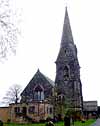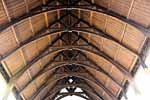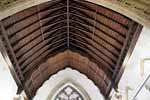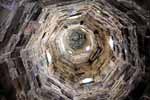For this church:    |
|
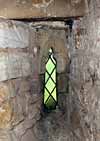 Reused window Reused window |
 Tower ladder Tower ladder |
The interior of the tower appears to be all re-used medieval stone up to the spire level and includes a re-used and re-set trefoil-headed window, probably of 13th century date, in the west wall of the access ladder projection. Access is by a purpose-built vertical ladder of fixed iron rungs set into stonework and appears contemporary with the date of construction.
Technical Summary
Timbers and roofs
Bellframe
There are two bellframes:
Original wooden frame, now empty, 3-bay Elphick type Z, Pickford Group 6.A with no corner posts. 1861.
Present frame all steel, Pickford 8.2.A with braces bolted to cill and head. Taylors of Loughborough, 1999.
Old frame not scheduled for preservation Grade 4; later frame Grade 5.
Walls
| NAVE | CHANCEL | TOWER | |
| Plaster covering & date | All plastered and painted 1861 and later | All plastered and painted 1861 and later | Open stonework |
| Potential for wall paintings | None evident, hidden stencil work a possibility. | None evident, hidden stencil work a possibility. | None. |
Excavations and potential for survival of below-ground archaeology
There have been no known archaeological excavations.
The fabric of the entire building dates to 1860-1 and later although there is re-used medieval masonry and a window inside the tower, and probably also on the north side of the church, which may be from the old chapel. Prior to construction the site comprised an agricultural field.
The churchyard is triangular with the church positioned to the south. There are burials on all sides.
The overall potential for the survival of below-ground archaeology in the churchyard is considered to be LOW mainly comprising evidence from the 1860-1 building phase, and the C20th extension building work, although the archaeological potential for the field which preceded the church is UNKNOWN. Below the present interior floors of the church it is considered to be LOW comprising mainly stratigraphy from the 1860-1 construction. The archaeology of the upstanding fabric in the body of the church is largely of a single period, 1860-1 but with some reused medieval material; its archaeological potential as representative of this date is HIGH.
Exterior:Burials no earlier than 1862 and burial ceased in the 1970s
Interior: Stratigraphy almost exclusively 1860-1.


